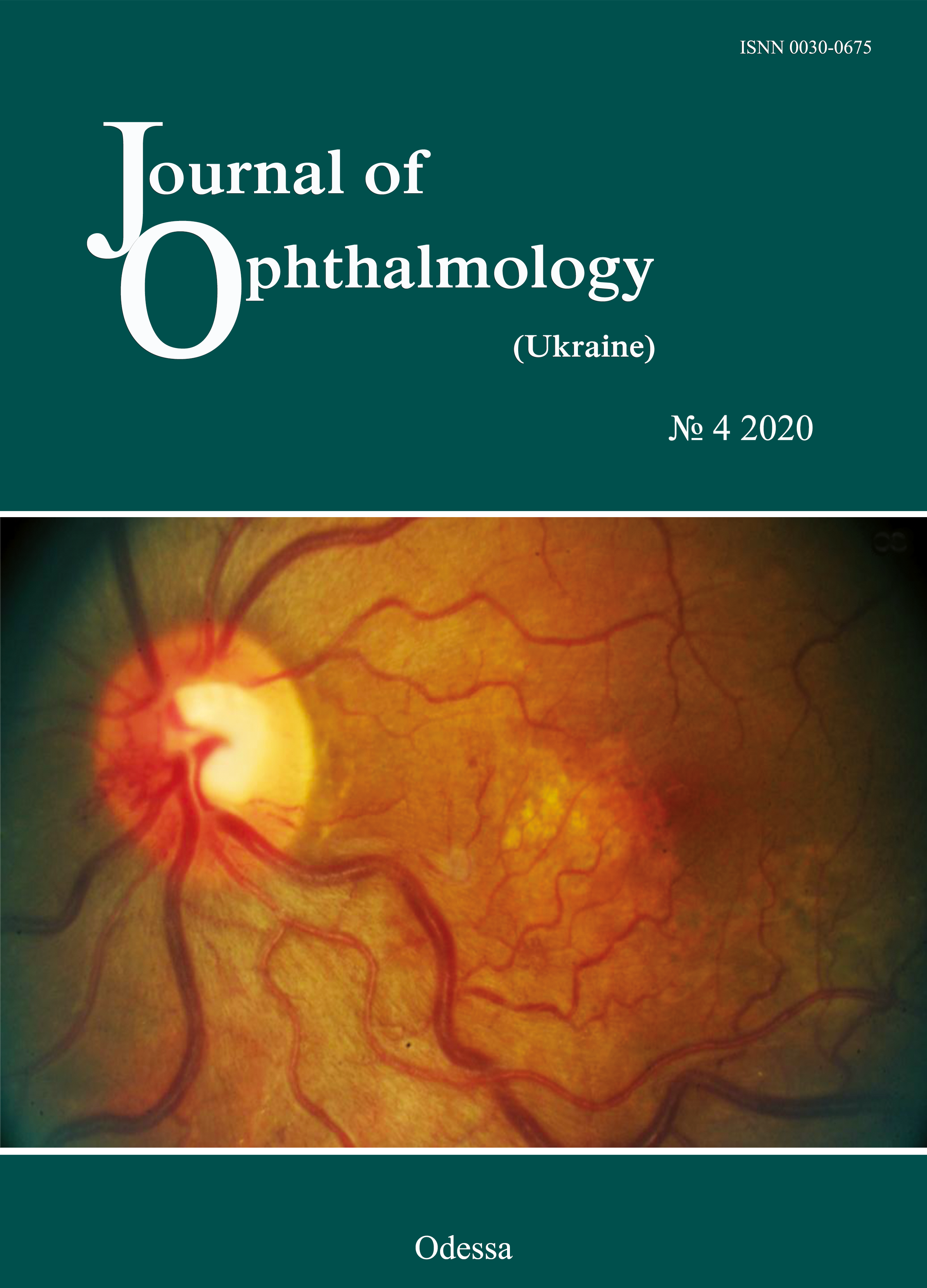Assessing in vitro cytotoxicity and pH of extracts of synthetic polymers made of cross-linked polyurethane composite with immobilized albucid
DOI:
https://doi.org/10.31288/oftalmolzh202045661Keywords:
cross-linked polyurethane, albucid, implant, reconstructive surgery on the eye, cytotoxicity, pH valueAbstract
Background: Because the prevalence of ocular trauma in Ukraine remains high, restorative and reconstructive surgeries in the orbit, adnexa, and periorbital area are important; their success, however, depends on the quality of implant materials. Previously, we have developed a polymer material made of cross-linked polyurethane (PU) and containing a biologically active substance, albucid; it seems to be a promising implant material.
Purpose: To assess in vitro cytotoxicity and pH of extracts of synthetic polymers made of cross-linked PU composites containing and not containing albucid.
Material and Methods: Cell culture methodology was applied to assess in vitro cytotoxicity of cross-linked PU composites containing and not containing albucid. Subcutaneous adipose tissue of albino Wistar rats was used as a source of cells to induce growth of fibroblasts and fibroblast-like cells under culture conditions. The pH value of water solutions was determined through the study of extracts of samples of PU composites containing and not containing albucid. The extracts were examined for pH using the general-purpose pH meter EV-74 supplied with glass pH electrodes.
Conclusion: It was demonstrated that fibroblast culture in Carrel flasks with controls as well as in those with extracts of samples of PU composites containing and not containing albucid was in a stable growth phase, indicating no toxic effect of the extracts on cultured cells. Polyurethane composites containing albucid were found to have a neutral pH value, which was within the acceptable range defined by hygiene standards.
References
1.Krasnovid TA. [Ocular trauma under present conditions. Providing urgent care in Ukraine]. Proceedings of the Conference of Ophthalmologists of Chernihiv, Kyiv, and other regions. Chernihiv; 2013. pp. 40-4. Russian.
2.Tselomudryi AI, Venger GE, Pogorelyi DN, Rizvaniuk AV. [Current system of stage-by-stage treatment for combat-related eye injuries in the area of ATO]. Visnyk morskoi meditsyny. 2016;2(71):196-203. Russian.
3.Grusha IaO, Fedorov AA, Dzemeshkevich VV, Blinova IV. [The clinical-and-morphological specificity of using xenopericardium in plasty of the eyelid and orbit]. Vestn Oftalmol. 2004 Sep-Oct;120(5):19-21. Russian.
4.Karaian AS. [One-stage repair of traumatic defects and deformations of the cheekbone, nose, and orbit complex]. [Dr Sc (Med) Dissertation]. Moscow: Central Research Institute for Dentistry and Maxillofacial Surgery; 2015. Russian.
5.Astakhov YuS, Nikolaenko VP, D'yakov VE. [Use of polytetrafluoroethylene implants in ophthalmic surgery]. St Petersburg: Foliant; 2007. Russian.
6.Maletskyy AP, Dubkova VI, Maievskaia OI, Bigun NM. [Results of the use of polymer composite Ikvoban in reconstructive surgery of the orbit and oculo-orbital region]. Oftalmologiia. Vostochnaia Evropa. 2013;special issue:188-97. Russian.
7.Chao DL, Harbour JW. Hydroxyapatite versus polyethylene orbital implants for patients undergoing enucleation for uveal melanoma. Can J Ophthalmol. 2015 Apr;50(2):151-4. https://doi.org/10.1016/j.jcjo.2014.11.007
8.Galatenko NA, Rozhnova RA. [Biologically active polymeric materials for medicine]. Kyiv: Naukova Dumka; 2013. Russian.
9.Rozhnova RA, Shilov VV, Galatenko NA. [Structural and morphological studies of biologically active implants with prolonged healing action]. Kompozitsiini polymerni materialy. 2000;22 (2): 146-50. Russian
10.Galatenko NA, Kulyesh DV, Maletskyy AP, Karpenko OS. Soft-tissue response to synthetic polymer implants made of cross-linked polyurethane and containing a biologically active substance, albucid or dacarbazine, in animals. J. Ophthalmol. (Ukraine). 2018; 6:52-8.https://doi.org/10.31288/oftalmolzh201865258
Downloads
Published
How to Cite
Issue
Section
License
Copyright (c) 2025 Н. А. Галатенко, Д. В. Кулєш, Л. Ф. Наражайко, В. П. Гриценко, Т. Ю. Закашун, А. П. Малецький, Н. М. Бігун

This work is licensed under a Creative Commons Attribution 4.0 International License.
This work is licensed under a Creative Commons Attribution 4.0 International (CC BY 4.0) that allows users to read, download, copy, distribute, print, search, or link to the full texts of the articles, or use them for any other lawful purpose, without asking prior permission from the publisher or the author as long as they cite the source.
COPYRIGHT NOTICE
Authors who publish in this journal agree to the following terms:
- Authors hold copyright immediately after publication of their works and retain publishing rights without any restrictions.
- The copyright commencement date complies the publication date of the issue, where the article is included in.
DEPOSIT POLICY
- Authors are permitted and encouraged to post their work online (e.g., in institutional repositories or on their website) during the editorial process, as it can lead to productive exchanges, as well as earlier and greater citation of published work.
- Authors are able to enter into separate, additional contractual arrangements for the non-exclusive distribution of the journal's published version of the work with an acknowledgement of its initial publication in this journal.
- Post-print (post-refereeing manuscript version) and publisher's PDF-version self-archiving is allowed.
- Archiving the pre-print (pre-refereeing manuscript version) not allowed.












